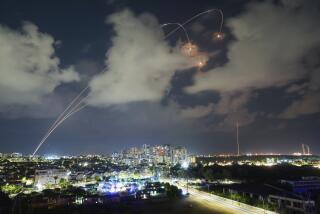Can We Be Protected by a Pig in a Poke?
- Share via
Once again we are being offered a ballistic-missile-pig-in-a-national-defense poke. This time the proposal being considered by the Clinton administration is much reduced from the missile defense systems of the 1970s or the unrealistic impenetrable umbrella of “Star Wars” in the 1980s. It is purported to be the national missile defense system, designed to protect the nation from an attack by a few intercontinental ballistic missiles launched by a rogue state--code words for Iraq, Iran, possible Libya and in particular North Korea--or from an accidental launch of a missile from Russia or China.
In all the tests of the current design, the system has performed poorly--often failing totally--even though the tests have been far from realistic. In particular, the testers always know weeks in advance when the attack is coming--knowledge that would be lacking in a real surprise attack. If the test operators decide they are not ready, they simply postpone the test. Even more serious is the failure to test against the kinds of countermeasures that would surely be employed by any nation capable of building ballistic missiles--for example, hiding the warhead in a cloud of indistinguishable decoys. There is also a tactic against which it is virtually impossible to test and against which the whole NMD fails catastrophically: A warhead carrying chemical or biological agents that disperses the payload in the form of hundreds of bomblets right after booster burnout would overwhelm the defense. In sum, the tests already carried out or planned are so unrealistic that they fail to provide any basis for the deployment decision promised by President Clinton for this summer.
Of course, there are many other ways besides ballistic missiles to deliver weapons of mass destruction to American targets. These include by airplane (to date the only way that such weapons have in fact been delivered), by cruise missile (really just a pilotless airplane) and by ship, either directly into a harbor or through the use of short-range missiles, or by smuggling it in. As the joke goes: Just hide it in a bale of marijuana and it is sure to get through.
Finally, consider the impact of an NMD deployment on our European allies and on China and Russia. The Europeans could interpret this as evidence of our fortress mentality and consider that it shows our reduced willingness to help them defend themselves against rogues or others if we ourselves are relatively impregnable. China and Russia may very well overestimate the efficacy of the proposed NMD and therefore feel the need to increase their offensive forces. Indeed, China has already made such a statement.
Worst of all, the NMD deployment cannot be carried out without violating the 1972 Antiballistic Missile Treaty or persuading Russia to join us in abandoning this treaty, which forbids the construction of a national missile defense. The ABM treaty has served as the cornerstone for all subsequent arms reduction treaties, including START I, START II and a potential START III. When completed, those treaties would decrease significantly the number of weapons currently aimed at the U.S. and Russia. Moreover, the restraint shown in establishing and maintaining all these treaties is an essential part of our efforts to convince other important powers to reduce or even eliminate their nuclear weapon stockpiles.
It would be tragic were we to proceed with deployment of a missile defense system that would be very costly (estimates range up to $60 billion), would be totally ineffective and would threaten to revive an arms buildup that we are just now getting under control.
More to Read
Sign up for Essential California
The most important California stories and recommendations in your inbox every morning.
You may occasionally receive promotional content from the Los Angeles Times.













